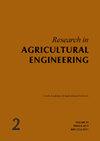含水率和速度对单宁刀切削力和能量的影响
Q3 Agricultural and Biological Sciences
引用次数: 1
摘要
采用响应面法(RSM)研究了水分含量和切削速度对单宁切削力和切削能的影响。含水率和切削速度分别为95.79、113.68、136.68、168.42、242.11%(干基)和10、15、20、25、30 mm×min-1。当含水率为168.42和113.68%,切削速度为10和20 mm×min-1时,切削力最大值为114.09 N,最小值为63.99 N。当含水率为136.68%,切削速度为10 mm×min-1和20 mm×min-1时,切削能最高为0.92 J,切削能最低为0.49 J。预测切削力和能量随切削速度和含水率的回归模型表明,所研究的性质与所考虑的自变量之间不存在线性关系,这可能归因于单宁的非均匀性。当切削力和切削能分别为72.89 N和0.60 J,切削力和切削能分别为95.79%和22.33 mm×min-1,切削力和切削能的理想值为0.80。研究结果可为单宁切屑机的研制提供参考。本文章由计算机程序翻译,如有差异,请以英文原文为准。
Influence of the moisture content and speed on the cutting force and energy of tannia cormels
This study investigated the influence of the moisture content and speed on the cutting force and energy of tannia cormels using the response surface methodology (RSM). The moisture content and cutting speed were varied over five levels each [95.79, 113.68, 136.68, 168.42, 242.11% moisture content (dry basis) and 10, 15, 20, 25, 30 mm×min–1, respectively]. The highest and lowest cutting forces were 114.09 and 63.99 N at the corresponding moisture contents of 168.42 and 113.68% and at cutting speeds of 10 and 20 mm×min–1, respectively. The highest and lowest cutting energies of 0.92 and 0.49 J were both obtained at a 136.68% moisture content, at the 10 and 20 mm×min–1 cutting speeds, respectively. The regression models for predicting the cutting force and energy as a function of the cutting speed and moisture content showed that there was no linear relationship between the investigated properties and the independent variables considered which could be attributed to the non-homogeneous nature of tannia cormels. The optimum cutting force and energy were 72.89 N and 0.60 J, respectively, at a 95.79% moisture content and a 22.33 mm×min–1 speed with a desirability of 0.80. These findings could serve as a guide for the development of chipping and cutting machines for tannia cormels.
求助全文
通过发布文献求助,成功后即可免费获取论文全文。
去求助
来源期刊

Research in Agricultural Engineering
Engineering, agriculture-
CiteScore
1.40
自引率
0.00%
发文量
21
审稿时长
24 weeks
期刊介绍:
Original scientific papers, short communications, information, and studies covering all areas of agricultural engineering, agricultural technology, processing of agricultural products, countryside buildings and related problems from ecology, energetics, economy, ergonomy and applied physics and chemistry. Papers are published in English.
 求助内容:
求助内容: 应助结果提醒方式:
应助结果提醒方式:


